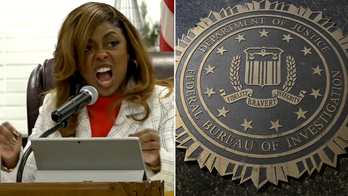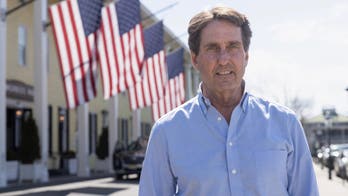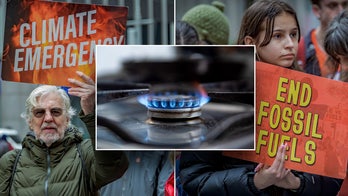In a video posted to social media on Monday, New York City Mayor Bill de Blasio again directly blamed climate change for 2012's deady Superstorm Sandy -- a contention that lacks scientific support - and touted his plan to spend $10 billion to fortify and "protect Lower Manhattan" against future storms.
Even as local leaders warned that de Blasio's plan to construct new barriers would actually destroy the waterfront neighborhoods he says he wants to protect, de Blasio insisted his views were now mainstream among New Yorkers.
"After Sandy, there weren't a lot of climate change deniers left in New York City," de Blasio said directly into the camera, after reminding viewers that the storm left dozens dead and cost the city billions in economic losses. "We need to protect this city and this country, and this world, from global warming. There's no national policy to do it right now. ... We have to do it ourselves."
Mayor de Blasio added in the video, which appeared on Facebook and Twitter, that the federal government also must act quickly: "We have to fight for the bigger changes, like the Green New Deal," de Blasio said.
The mayor claimed that studies undertaken by his office and others has determined that if the city does not prepare for climate change, rising seas will expose 20 percent of lower Manhattan to daily flooding by 2100.
However, past expert predictions on the effects of global warming have proven inaccurate at best. For example, United Nations scientists predicted that the world had only 10 years to immediately address climate change all the way back in 1989, in order to protect entire cities from destruction and a resulting flood of eco-refugees. A NASA scientist falsely predicted the same thing in 2006.

FILE - In this Aug. 28, 2011 file photo, a bicyclist makes his way past a stranded taxi on a flooded New York City street as Tropical Storm Irene passes through the city. (AP Photo/Peter Morgan, File)
Contrary to de Blasio's assertions, no study has defintively linked the existence or power of Superstorm Sandy to man-made climate change, or made the claim that such a link can be definitively established at all. Some contested studies have, however, suggested the storm may have become more intense to some degree as a result of warming sea temperatures.
"We suggest that it is more useful to regard the extreme circulation regime or weather event as being largely unaffected by climate change, and question whether known changes in the climate system's thermodynamic state affected the impact of the particular event," stated one paper produced by researchers at the National Center for Atmospheric Research.
GREENPEACE CO-FOUNDER TEARS INTO OCASIO-CORTEZ: 'POMPOUS LITTLE TWIT'
The researchers added: "Some examples briefly illustrated include 'snowmaggedon' in February 2010, Superstorm Sandy in October 2012 and supertyphoon Haiyan in November 2013, and, in more detail, the Boulder floods of September 2013, all of which were influenced by high sea surface temperatures that had a discernible human component."
The Green New Deal backed by de Blasio has not attracted universal support even among Democrats, after the resolution's botched rollout in Congress earlier this year included the release of an official document by New York Rep. Alexandria Ocasio-Cortez's office that promised economic security even for those "unwilling to work," as well as the elimination of "farting cows" and air travel.
"We have to fight for the bigger changes, like the Green New Deal."
The Democratic mayor on Thursday first announced his plan to meet the "existential threat" of climate change, specifically by extending a section of the lower Manhattan coastline as much as 500 feet into the East River. He said the $10 billion effort to protect lower Manhattan from flooding by extending the shoreline between the Brooklyn Bridge and the Battery will be funded partly by private development if federal funds are not available.
WHAT DOES TRUMP ADMIN'S OWN CLIMATE CHANGE REPORT SAY IS COMING?
"If there's federal money in play, it probably looks one way," de Blasio said last week. "If there's not federal money in play, we have to get some private money into it and there has to be some development."
Officials have been developing schemes to fortify New York City's waterfront since Superstorm Sandy destroyed thousands of homes and businesses in 2012.
De Blasio said it will cost about $500 million to fortify most of lower Manhattan from future effects of climate change, including rising sea levels and intense precipitation, with grassy berms and removable barriers.
But planners determined that protecting the lowest-lying area, including South Street Seaport and the financial district, will require adding more land over several years.

FILE - In this Oct. 19, 2017 file photo, a boat crosses New York Harbor in front of the Manhattan skyline. Mayor Bill de Blasio is announcing a plan to protect lower Manhattan from rising sea levels by surrounding it with earthen berms and extending its shoreline by as much as 500 feet. (AP Photo/Mark Lennihan, File)
De Blasio, who is contemplating joining the crowded field of 2020 Democratic presidential candidates, said the $10 billion landfill project should be supported by federal funds, but that's unlikely to happen during the administration of Republican President Donald Trump.
"Lower Manhattan is one of the core centers of the American economy," he said. "It's where the financial capital of the United States is. The security of lower Manhattan should be a national priority. The fact is it is not. And it's incomprehensible to me that there's no sense of urgency from the federal government."
He added, "We can't afford to bury our head in the sand and that's right now what our federal government is doing."
The plan to extend the coastline will go through the city's environmental review process, de Blasio said, but he hopes to avoid "the endless dragging on that usually accompanies something of this scale."
But the prospect of private development on the newly built land is sure to meet resistance from downtown Manhattan community members.
City Council member Margaret Chin, who represents the area, said a more resilient future "cannot be paid for by private real estate development that would destroy the waterfront neighborhoods that we are trying to protect."
De Blasio announced the climate resilience plan at a news conference after previewing it in New York magazine .
"This is the existential threat," de Blasio said. "This is the core issue we all must face as aggressively as humanly possible."
The Associated Press contributed to this report.





